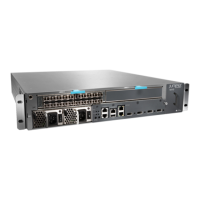

Do you have a question about the Juniper M Series and is the answer not in the manual?
| Product Series | M Series |
|---|---|
| Type | Network Router |
| Manufacturer | Juniper Networks |
| Throughput | Varies by model |
| Operating System | JUNOS |
| Switching capacity | Varies by model |
| Supported Interfaces | ATM |
| Routing Capacity | Varies by model |
| Forwarding Performance | Varies by model |
| Maximum Number of Interfaces | Varies by model |
| Power Supply | Redundant power supplies available |
| Line rate | Varies by interface type |
| Key Features | Advanced routing protocols |
| Redundancy | Redundant power supplies |
| Dimensions | Varies by model |
| Weight | Varies by model |
| Memory | Varies by model |
| Storage | Varies by model |
| Environmental Conditions | Operating temperature: Typically 0°C to 40°C, Humidity: 10% to 90% non-condensing |
Details how to check router component status by inspecting LEDs, craft interface, and obtaining CLI output.
Describes how to test a component for failure, often by performing a swap test, without compromising router integrity.
Provides guidance on taking action to correct router alarm conditions, including component replacement or escalation.
Describes the Packet Forwarding Engine's role in Layer 2/3 packet switching, route lookups, and forwarding.
Describes the Routing Engine's function, components, and its interaction with the Packet Forwarding Engine.
Details how to check the status of installed router chassis components via CLI and faceplate inspection.
Describes how to verify component failure, typically by performing a swap test on the component.
Provides instructions on replacing a failed component, including locating serial numbers and obtaining RMA.
Details how to monitor the Routing Engine status to confirm proper functioning and check for alarms.
Details how to check FPC status and utilization, uptime, temperature, and LED states.
Provides steps to verify FPC failure, including checking connections, fuses, and performing swap tests.
Describes the procedure for replacing an FPC, including taking it offline and handling components.
Details how to check the craft interface status and environmental status.
Provides steps to verify craft interface failure, including checking alarms and error messages.
Describes the procedure for replacing the craft interface, including ESD precautions and removal steps.
Explains how to check power supply status and environmental status via CLI and LEDs.
Provides steps to verify power supply failure, including checking switches, circuit breakers, and performing swap tests.
Describes the procedure for replacing power supplies, including safety precautions and hot-swap capabilities.
Details how to check the cooling system status, including fan and impeller operation.
Describes how to verify a fan failure by performing a swap test and checking connections.
Describes the procedure for replacing cooling system components, emphasizing hot-swap capabilities.
Explains how to check PIC port status by examining PIC or FPC LEDs and using CLI commands.
Details how to check the host subsystem status using the CLI and craft interface LEDs.
Describes how to check the Routing Engine status, including state, temperature, and CPU utilization.
Explains how to monitor the Control Board status, including environmental and LED indicators.
Details how to monitor the Control Board status, including environmental and craft interface information.
Describes the procedure for replacing a Control Board, including swap tests and ESD precautions.
Details how to monitor the SCG status, including environmental status and LED states.
Describes how to monitor SIB status, including summary status, LED states, and environmental status.
Provides steps to verify SIB failure by checking connection, fuses, and performing swap tests.
Provides a checklist for monitoring the System Control Board (SCB), including status, alarms, and hardware information.
Provides a checklist for monitoring the System and Switch Board (SSB) for proper allocation and transfer of data packets.
Provides a checklist for monitoring Compact Forwarding Engine Boards (CFEBs) for route lookup, filtering, and switching.
Details how to monitor High-Availability Chassis Managers (HCMs) for control and monitoring functions.
Explains how to monitor Fixed Interface Cards (FICs) for packet reception, transmission, and system alarm status.
Provides a checklist for monitoring Forwarding Engine Boards (FEBs) for proper forwarding processes.
Details how to monitor redundant Routing Engines, including status, mastership, and alarms.
Explains how to monitor redundant power supplies to ensure uninterrupted power distribution.
Provides a checklist for monitoring redundant cooling system components for acceptable operating temperatures.